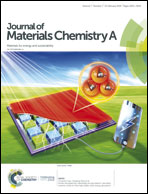Tailoring natural layered β-phase antimony into few layer antimonene for Li storage with high rate capabilities†
Abstract
Downsizing alloy anode materials has been demonstrated as an efficient strategy to alleviate volume expansion and prolong the cycling performance for lithium (Li) ion storage. However, dimension and size dependent Li-ion diffusion and battery performances have scarcely been explored. This work was carried out to determine the tailored engineering required to create a natural layered material, β-phase antimony (Sb), and identify the dimension and size effects on the Li ion storage performance, which is of particular interest for alloy anode materials at present. Two types of tailored engineering, in the vertical direction and omnidirectional, were adopted to produce few layer antimonene and Sb nanoparticles (NPs) using ultrasonication regulation. In the absence of helpful fluoroethyl carbonate additives, tailored engineering can still improve the cycling stability and the reversible capacity, and the lateral size dominated two-dimensional (2D) antimonene exhibits a higher rate performance than Sb NPs. In situ electron microscopy analysis reveals the limited expansion of the lateral size for 2D antimonene upon lithiation. Theoretical simulation reveals that the in-plane diffusion energy barrier (0.25 eV) for layered β-phase Sb is much smaller than the diffusion energy barrier across its interlayers (1.14 eV). Therefore, the unique 2D antimonene with large lateral size can achieve better high rate performance than Sb NPs, and also has stable capacity for Li ion storage.



 Please wait while we load your content...
Please wait while we load your content...